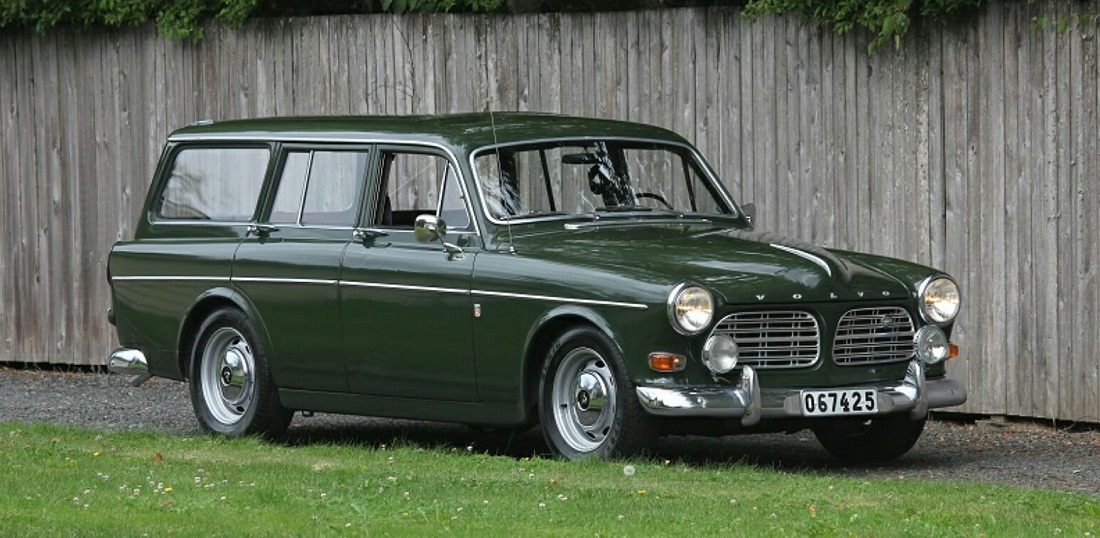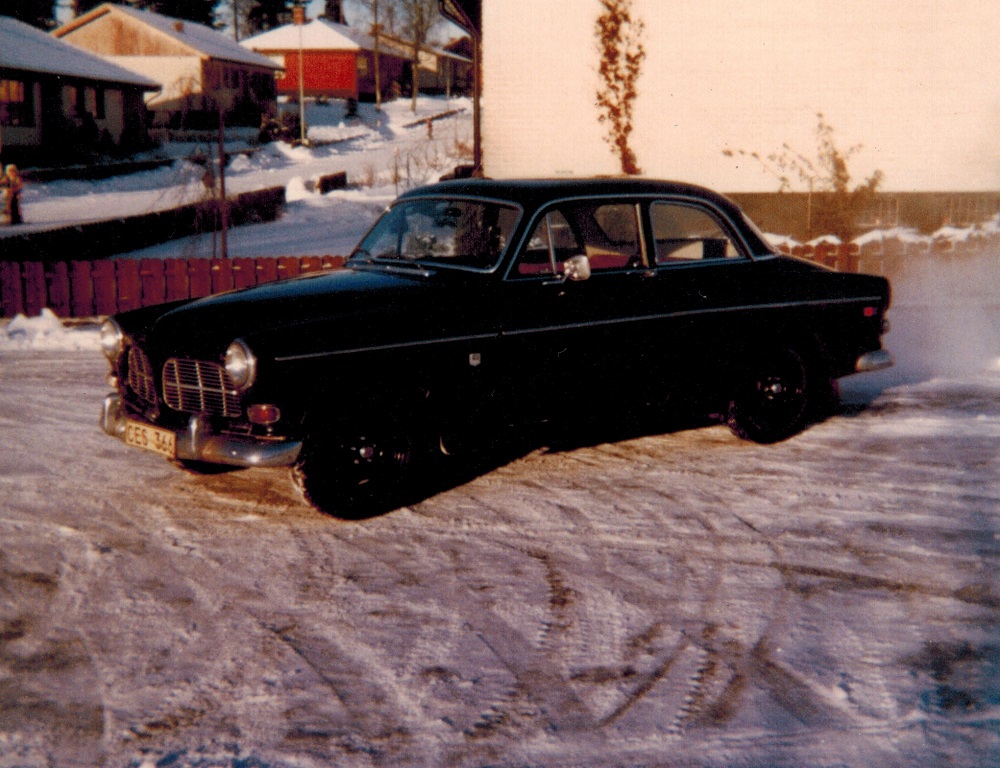
The reason most of us drive vintage cars is that they remind us of something “back in the day”. Maybe you owned one, or had a friend that had one or maybe you just saw one rolling down the road when new. Whatever it was, we are re-living that moment as soon as you enter the driver’s seat.

In my case, my dad had this exact car and as kids we were bouncing around in the back seat.
Here is the Editor’s totally self-absorbed and self-promoting story of my 1967 Volvo Amazon wagon:

The whole family was pretty much a Volvo family, I guess it would be like owning a Chevrolet in America.
I remember being towed behind my dads wagon on an wooded sled on a frozen lake. That ended when the police (in a black and white 122S wagon) pulled us over.

My mom getting in or out of our 122 wagon probably late sixties.

When I was old enough to drive, I owned several Volvos, most of them were 120 series cars.
One of my first Volvos. I think it was a 1966. Note red side marker lens on rear quarter from US market cars. What we don’t have, we think is cool. Since I could not afford the wider wheels, removing the hub caps and installing chrome lugs was the next best thing. This car also had the Simons sport exhaust system.

This is the first car I had repainted. I think this was a 1966 model as well. Note Hella yellow fog lights on the bumper.

Burnout! 1970 Volvo 122 with B20 power smoking the Michelin 165/15 radials on a lonely piece of blacktop somewhere in Sweden.

This was my older brother Lennart’s 122. 5.5 inch wheels, ralley lights and flat black hood was the look!

This was my younger brother Lars’ Volvo 142. Check out cool placement of the antenna.

Something about Swedes and burnouts!

Lars later upgraded to this beautiful Volvo 164. Six cylinder with four speed overdrive. Note rare optional aluminum rims. This car was never dirty!

Sorry for crappy photo but hey…By this time, dad had a blue metallic Volvo 264 GL as a company cars. It was the first car I drove with cruise control.
“Back in the day”, there were some must-have’s if you could afford it: Leather steering wheel, KPZ 5.5 inch wide wheels. If you could not swing the KPZ wheels, you would at least remove the hubcap so it looked “rally”.
A two inch sport exhaust system was important and auxiliary lights like Hella, Marshall or Cibie. Let’s see how many items on the mandatory list we can check off on this car.
So…in 1967: Thurgood Marshall was the first African American to be appointed to the Supreme Court, Disney released a film called The Jungle Book and Sweden decided to start driving on the right side of the road.
Mary and Dick, a couple from Seattle did a European Delivery with this 122S wagon. They drove the car all over Europe before returning it to Volvo for shipment back to the US.
They picked it up before Sweden switched to right side driving so they had to drive on the left side to the ferry in southern Sweden and then switch sides as they got off the ferry in Denmark. Back then, a ferry was the only way to connect to southern Europe.

It’s all greek to me! Service receipt from Greece.

They sure did get around! Here is another invoice from Volvo/Auto Union/DKW dealer on Schwarztorstrasse 71, Bern, Switzerland, dated July 14, 1967. There are apartments there now!
I purchased it from Mary in 2010 and that makes me the second owner.

The car sits on Lesjöfors 30mm lowering springs and gas shocks are doing the shocking part.

I replaced all the chrome with nice used parts and added new rear bumperettes.


There is a saying in Sweden that goes: “kärt barn har många namn” it means “a beloved child has many names”. That may explain why the 122 station wagon is called Combi, Wagon, Estate, long roof, shooting brake etc. In Sweden the wagon was referred to as a Kombi or Herrgårdsvagn.
When I got the car it had ugly 14 inch Mazda wheels, black modern mirrors and faded bumpers. The good news: they still had the stock 15X4.5 stock rims.

The pilot house: A Moto-Lita leather steering wheel checks of the mandatory list and adds to the driving experience. Mickey Mouse floor mats…why not?!

The wagons had a 4.56 rear end ratio and that was great for hauling or on Swedish gravel roads but not so much for speed. I added an overdrive and now I can cruise at 70mph without exploding the engine. Factory column mounted stalk and OD indicator light on dash.

The bucket seats that are covered with Swedish Nagahyde are sporting chrome Recaro seat adjusters. They were only on the 123GT and 1800 cars but I added them for comfort.

Back seat looks inviting as well.

The stock 15X4.5 wagon wheels are safely stored away if I for any reason wanted to go “all stock”. Until then, I am very happy to roll around on these 15X5.5 rims. They were all the rage when I grew up in Sweden in the sixties and seventies. Also, removing the hub cap and using a chrome center cap and chrome lug nut was the ultimate setup.

The front license plate is an actual 1967 plate from Sweden.
First letter “O” stands for Göteborgs och Bohus Län as in the county Gothenburg resides and this is also the location for the Volvo factory.

I want good lights on my cars but I don’t like the flat lens on the Hella e-code on a bulbous vintage car but I sure like the quality reflector and the output from the H4 halogen bulb. So…I removed the flat lens from a set of Hella e-codes and then attached these nice Auteroche lenses on. Best of both worlds.
The Hella fog lights below are the same model as the 123GT car but one inch smaller in diameter. They are mounted on 123GT brackets.

US cars came with all red tail and blinkers but Swedish cars had orange blinkers. What we don’t have here, we want.

Obviously not restored, just original. Plenty of room to haul kids, lumber or bodies. Back seat can be folded down for more room.

Here is a cool feature on the wagon you may not know about. When you haul your lumber back from the lumber yard, here is how you stay legal.

The plate including the lights swing out so your plate is visible when the tailgate is down.

A Blaupunkt Frankfurt does a good job looking era correct. Thanks Gary!

The stock B18 have the number designation 496840 and that means 115 hp Sport motor. These cars also came with a single Zenith carburetor but not for US market. They were called 121. Chrome valve cover adds horsepower and torque.

Lets decode this baby:
222441 M
First and second number “22” is wagon as in P220 (122 wagon)
Third number 2 = B18D Sport motor
Fourth number “4” = USA export
Fifth number “4” = gearbox, in this case 4 speed
Sixth number “1” = Steering wheel position – Left Side
(A “2” would be right side steering)
M = 1967 as in is model year
Code 94 is Dark Green Paint
519-555 Brown leatherette
Future plans may be to repaint the car and install the factory style fender mirrors. Only the 123GT and wagons came with fender mirrors. I have a set of those mirrors but then I would have to remove the door mirrors and then I might as well paint the whole car.

I also would like to install my NOS speedometer but then I might as well replace the dash cap and down the rabbit hole I go. So for now, I will just maintain and keep on driving, I got to stay focused on the P1800 project!
There you have it, the Editor’s ride.
